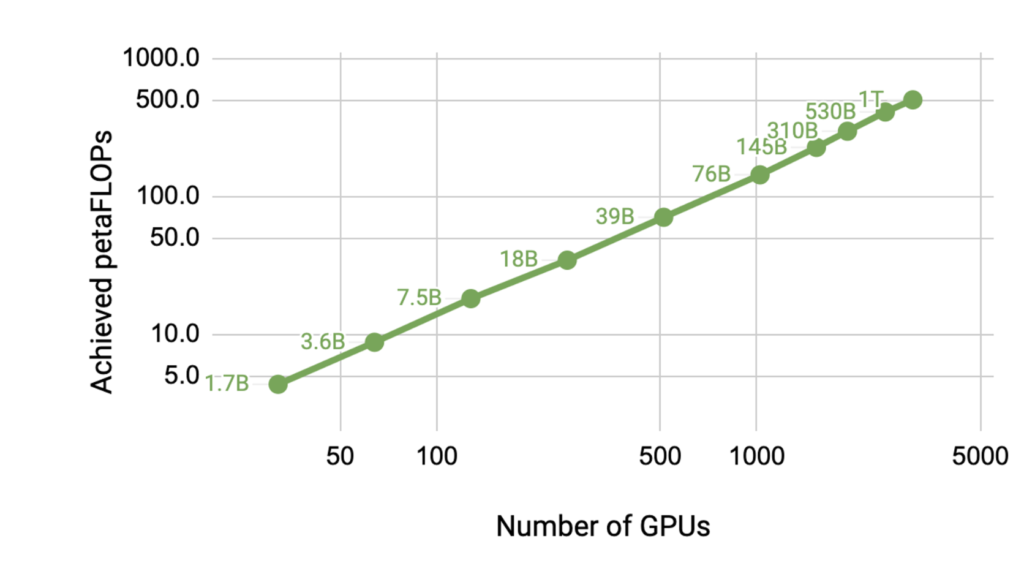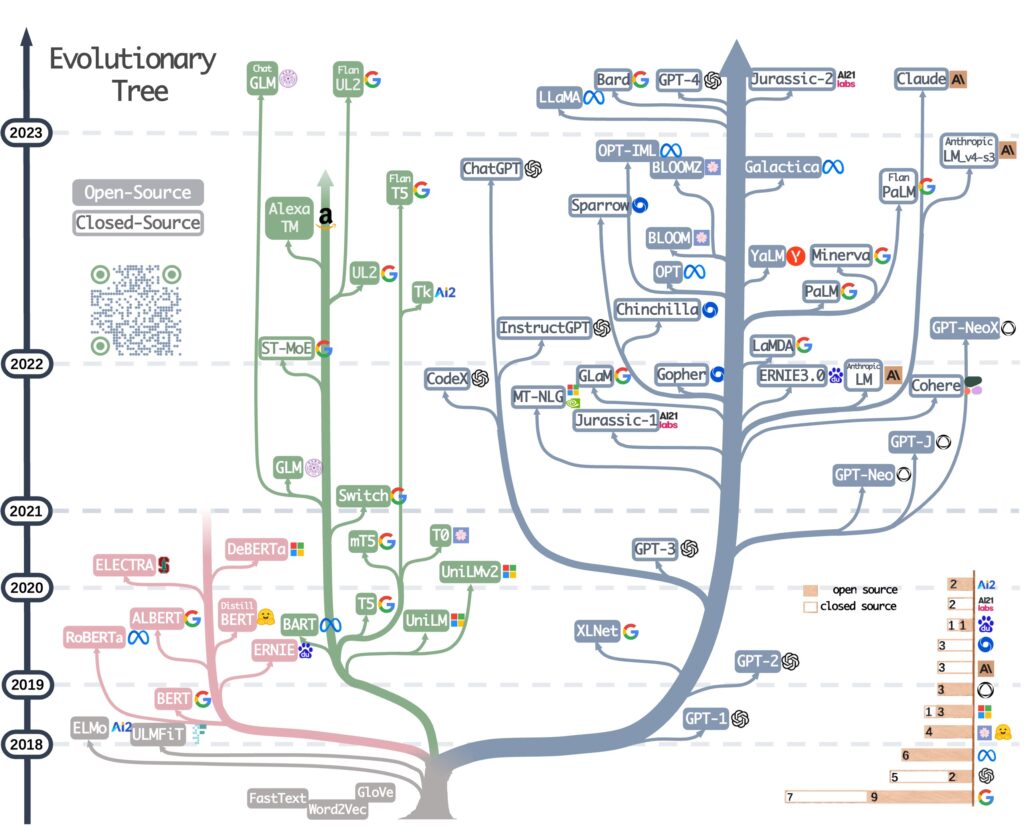Unleashing the Power of AI: Exploring Emergent Abilities
Emergent Abilities of AI in Large Language Models by Steven Hatzakis, co-written with Chat-GPT (Views are my own and not that of my employer)
Artificial Intelligence (AI) has been one of those cliche buzzwords that startups have been throwing around for years. However, AI has recently undergone a massive quantum leap in its evolution, and with 100 million people adopting the use of the technology (i.e. Open AI’s Chat-GPT service) faster than any other technology in the history of humankind. Below we discuss some of the drivers of these trends and how it is impacting the world now and its future path.
Introduction: Artificial Intelligence (AI) has rapidly evolved, unveiling remarkable emergent abilities that reshape industries. Language Model-based AI systems, like Large Language Models (LLMs) and advanced models such as Google’s PaLM (and recently launched Bard.google.com) and OpenAI’s GPT-3 (and recently launched Chat GPT), revolutionize language understanding and generation, due to the billions of parameters used and power of parallel processing. These advancements power transformative AI applications with the potential to revolutionize the world.
For example, Megatron can achieve 1 trillion parameters using thousands of GPUs, according to research by NVIDIA running on their Selene supercomputer.

In this article, we explore the profound impact of LLMs like PaLM and GPT-3. From natural language understanding to creative content generation, these AI systems push the boundaries of what machines can achieve, with 100 examples of emergent AI capabilities.

Large LLM’s and NLP is fueling AI adoption
The rise of Natural Language Processing (NLP) is fueling the quantum leap that is currently happening with AI. NLP enhances human interaction with AI, transforming how we communicate with technology. It finds applications in virtual assistants, chatbots, sentiment analysis, and language translation, improving customer service and data analysis. As more and more code and tools because open-source, developers and consumers will have access to use AI-related tools.
def from_pretrained(
pretrained_model_name_or_path,
*,
cache_dir=None,
force_download=False,
no_cache=False,
revision=None,
prompt_encoder_model_path=None,
**kwargs,
):
if pretrained_model_name_or_path is None:
raise ValueError("The `pretrained_model_name_or_path` argument is required.")
if isinstance(pretrained_model_name_or_path, str):
resolved_path = cached_path(
pretrained_model_name_or_path,
cache_dir=cache_dir,
force_download=force_download,
no_cache=no_cache,
)
else:
resolved_path = pretrained_model_name_or_path
######################################
# Instantiate GPT3Model and Load Weights
######################################
# Instantiate the GPT3Model with provided arguments
model = GPT3Model(
**kwargs,
prompt_encoder_model_path=prompt_encoder_model_path,
revision=revision,
)
# Load the pre-trained model weights
model.load_state_dict(torch.load(resolved_path, map_location="cpu"))
return modelAs AI continues to advance in NLP and other domains, it integrates into various industries, improving healthcare, transportation, and education, as well as finance and other industries. Ethical considerations around privacy, fairness, and transparency shape AI’s future. The dynamic and evolving field promises ongoing innovation and transformative applications.
Forex-GPT

In mid-May 2023, I got early access to Open AI’s plugins for Chat-GPT, including developer access, and built a Chat GPT plugin over the span of a weekend.
The plugin for Chat GPT is called Forex-GPT and interacts with forex broker APIs to allow users to query forex market prices and analysis from within the chat GPT interface, currently available as an unverified plugin (for advanced users, as it requires technical installation).
I did this as an experiment – and even used Chat-GPT to assist me in developing the code for the plugin, and was thrilled that I got it to work (after some hefty debugging). This made me also wonder what other interesting products and services will be available in the near future powered by cutting-edge AI technology, that are already being developed.
Here is an example below of how the Forex-GPT plugin works (that version is limited to time-frames as the size of the message will reach the maximum token size allowed on GPT-4, which is 4098 tokens).

More and more I continue to see AI-related products flooding social media channels, almost to the point of saturation, but the pie will only get bigger and that leads us to our next section of 100 emergent AI capabilities.
Emergent AI Unveiled: 100 Remarkable Capabilities Shaping the Future
As LLMs scale to have hundreds of billions of parameters, the emergent capabilities of such systems increase, which means the AI can be more creative at problem-solving and have higher comprehension abilities (i.e. even if you spell something wrong, it will be likely to still understand the meaning of your text).
This is especially true when you combine chain-of-thought prompting to unlock more of the AI’s emerging capabilities, which may have been previously unknown to its creators and researchers (i.e. something, such as a task, the AI can do that no one anticipated).
- The featured image for this article was created with AI, using a prompt on Midjourney as well as the image here below:

Below are 100 emergent capabilities from AI, some more basic than others, that will continue to shape the future of humankind for many years to come.
100 Emergent AI abilities:
- Natural language understanding: I can comprehend and interpret various forms of written text, allowing me to understand the context and meaning of the prompts I receive.
- Contextual responses: I can provide responses that take into account the information provided in the conversation and maintain a coherent dialogue.
- Knowledge synthesis: I can integrate information from a wide range of topics, drawing from my training on diverse datasets, to provide informative and relevant responses.
- Creative writing: I can generate original text, including stories, poems, and essays, based on the given prompts or topics.
- Language translation: I can assist with translation between different languages, although my proficiency varies depending on the language pair.
- Text completion and generation: I can help with writing tasks by providing suggestions, completing sentences, or generating coherent paragraphs on a given topic.
- Answering questions: I can provide factual information and answer questions to the best of my knowledge based on the training data available to me (knowledge cutoff in September 2021).
- Sentiment analysis: I can understand and analyze the sentiment expressed in text, determining whether it is positive, negative, or neutral.
- Summarization: I can summarize long passages of text, condensing the main points and key details into a shorter, more concise form.
- Contextual reasoning: I can reason through complex scenarios and provide logical responses based on the given context and information.
- Image recognition: While I primarily work with text, I can also process and describe images to some extent, although my capabilities in this area are more limited compared to specialized image recognition models.
- Code generation: I can assist with generating code snippets or providing guidance on programming-related topics, although I’m not a substitute for professional developers or dedicated coding environments.
- Personalized language style: I can adapt my responses to mimic different styles, tones, or personalities, based on the desired specifications provided by the user.
- Continuous learning: While I’m based on the GPT-3.5 architecture, I don’t have the ability to learn or update my knowledge in real-time. My responses are based on the information available to me up until September 2021.
- Multi-turn conversations: I can engage in back-and-forth conversations, remembering the context from previous messages to maintain coherence throughout the dialogue.
- Contextual understanding of world events: I can provide insights and information about current events, news, and popular topics, helping users stay updated with the latest information.
- Text generation in multiple languages: I can generate text in various languages, although my proficiency may vary depending on the language and available training data.
- Text-based games and interactive storytelling: I can participate in text-based games or interactive storytelling experiences, where users can engage in a narrative and make choices that influence the outcome.
- Knowledge exploration and fact-checking: I can assist in researching and fact-checking specific pieces of information by accessing and cross-referencing my available knowledge base.
- Sentiment and emotion analysis: I can identify and analyze the emotional tone and sentiment expressed in text, helping users understand the underlying emotions conveyed in written content.
- Language generation for chatbots and virtual assistants: I can be used as the underlying technology for chatbots and virtual assistants, enabling them to engage in human-like conversations and provide helpful responses.
- Content creation support: I can provide suggestions, ideas, and help with generating content for various purposes, such as writing articles, blog posts, or creative projects.
- Text-based customer support: I can be used to handle basic customer support inquiries by providing relevant information, answering frequently asked questions, or directing users to appropriate resources.
- Virtual tutoring and educational support: AI models can assist in providing personalized educational content, explanations, and guidance across various subjects and academic levels.
- Content moderation and filtering: AI models can be utilized to identify and filter out inappropriate or harmful content, helping to maintain a safer online environment.
- Data analysis and pattern recognition: AI models can process and analyze large volumes of data, helping identify patterns, trends, and insights that may not be immediately apparent to humans.
- Voice assistant integration: AI models can be integrated into voice assistant devices, allowing users to have natural language conversations and obtain information or perform tasks using voice commands.
- Context-aware recommendation systems: AI models can analyze user preferences and behavior to provide personalized recommendations for products, services, movies, music, and more.
- Medical diagnostics and support: AI models can assist healthcare professionals by analyzing medical data, providing diagnostic insights, and offering recommendations for treatment options.
- Speech synthesis and voice generation: AI models can be used to generate realistic and natural-sounding human voices for applications like voice-overs, audiobooks, and voice assistants.
- Creative content generation: AI models can aid in generating creative content such as artwork, music compositions, or poetry based on specific themes or styles.
- Natural language interfaces for software and applications: AI models can provide more intuitive and conversational interfaces for software and applications, enhancing the user experience.
- Sentiment analysis for market research: AI models can analyze customer feedback, reviews, and social media posts to gauge public opinion and sentiment about products, brands, or events.
- Transcription and speech recognition: AI models can transcribe spoken language into written text, enabling automatic transcription services and facilitating accessibility for individuals with hearing impairments.
- Virtual collaboration and brainstorming: AI models can be utilized to facilitate virtual collaboration, providing suggestions, ideas, and creative input during brainstorming sessions or group discussions.
- Language localization and cultural adaptation: AI models can assist in adapting content and language to specific regions or cultural contexts, ensuring that communication and messaging are culturally appropriate and relevant.
- Personalized virtual assistants: AI models can serve as personalized virtual assistants, learning from user interactions and providing tailored recommendations, reminders, and assistance based on individual preferences.
- Text generation for chat applications and social media: AI models can generate text for chat applications, social media platforms, and other online communication tools, enhancing the user experience and automating certain tasks.
- Language proficiency assessment and language learning: AI models can assess language proficiency levels and provide personalized language learning resources, exercises, and feedback to aid in language acquisition.
- Speech-to-text translation: AI models can convert spoken language from one language to another in real-time, enabling speech-to-text translation services for multilingual communication.
- Psychological support and mental health assistance: AI models can be used to provide basic psychological support, offering resources, coping strategies, and information related to mental health topics.
- Content generation for virtual reality and augmented reality: AI models can generate text and descriptive content for virtual reality and augmented reality experiences, enhancing the immersive nature of these technologies.
- Legal and technical document analysis: AI models can assist in analyzing and summarizing legal documents, contracts, and technical manuals, saving time and improving efficiency in document review processes.
- News and content aggregation: AI models can aggregate and summarize news articles, blog posts, and other forms of content, helping users stay informed on specific topics of interest.
- Interactive storytelling and game development: AI models can be used to create interactive narratives, game characters with natural language interactions, and dynamic storylines, enhancing the gaming experience.
- Semantic search and information retrieval: AI models can assist in improving search engines and information retrieval systems by understanding the meaning and context behind search queries, leading to more accurate and relevant results.
- Speech coaching and language training: AI models can provide feedback and guidance for improving public speaking, pronunciation, and language fluency, acting as virtual language coaches.
- Content recommendation and personalization: AI models can analyze user behavior, preferences, and historical data to provide personalized content recommendations across various platforms and applications.
- Legal and medical research assistance: AI models can assist legal and medical professionals in conducting research, analyzing case studies, and providing insights into relevant regulations, laws, or medical literature.
- Cybersecurity and fraud detection: AI models can help identify patterns and anomalies in data to detect cybersecurity threats, fraudulent activities, or potential security breaches.
- Dialogue systems and chatbots for customer service: AI models can be employed in chatbot applications to provide automated customer support, answer frequently asked questions, and assist users with inquiries.
- Content generation for marketing and advertising: AI models can generate compelling copy for advertisements, social media posts, and marketing campaigns, optimizing messaging and engagement.
- Language assessment and proficiency tests: AI models can evaluate language proficiency levels and conduct language assessments, providing accurate evaluations for language learners and test-takers.
- Historical data analysis and predictions: AI models can analyze historical data patterns, enabling predictions and forecasts in various domains such as finance, weather, or social trends.
- Personalized health and fitness recommendations: AI models can offer personalized advice, exercise routines, and dietary suggestions based on individual health goals and preferences.
- Speech synthesis and voice cloning: AI models can generate synthetic speech in a specific voice, including the ability to mimic the voice of a particular individual, enabling applications such as voice assistants or audiobook narration.
- Knowledge base creation and maintenance: AI models can assist in creating and updating knowledge bases by automatically extracting information from various sources, organizing it, and generating summaries or explanations.
- Virtual tour guides and travel assistants: AI models can provide information, recommendations, and interactive experiences as virtual tour guides, helping travelers navigate destinations and learn about local attractions.
- Sentiment analysis for social media monitoring: AI models can analyze social media posts and comments to gauge public sentiment and opinion about brands, products, or events, enabling companies to gather insights for marketing strategies.
- Language correction and editing: AI models can help with grammar and language correction, suggesting improvements, rephrasing sentences, and enhancing the overall clarity and coherence of written text.
- Intelligent content generation for journalism: AI models can assist journalists by providing data-driven insights, background information, and even generating initial drafts for news articles, aiding in research and writing processes.
- Personality-based chatbots and virtual companions: AI models can be customized to embody specific personalities, allowing for more engaging and interactive chatbot experiences or virtual companions.
- Emotion detection and affective computing: AI models can analyze text to detect emotions and sentiments, enabling applications in emotional analysis, customer feedback analysis, or mental health monitoring.
- Speech-to-speech translation: AI models can translate spoken language from one language to another in real-time, facilitating communication between individuals who speak different languages.
- Content filtering and parental controls: AI models can be employed to identify and filter inappropriate or sensitive content, helping parents and guardians ensure a safer online environment for children.
- Conversation simulators and language practice: AI models can simulate conversations in various scenarios, allowing users to practice language skills, negotiation techniques, or difficult conversations.
- Personalized news and content curation: AI models can curate news articles, blog posts, and other content based on individual preferences, interests, and reading habits, tailoring information delivery to each user.
- Writing assistance for individuals with disabilities: AI models can provide writing assistance and support for individuals with disabilities, including those with dyslexia, visual impairments, or motor limitations.
- Language preservation and revitalization: AI models can assist in documenting and preserving endangered languages by creating language resources, generating translations, and aiding in language revitalization efforts.
- Ethical decision-making support: AI models can provide ethical analysis and guidance by helping individuals and organizations navigate complex ethical dilemmas and consider various perspectives.
- Real-time news analysis and fact-checking: AI models can analyze news articles, social media posts, and online content in real-time, fact-checking claims and identifying misinformation or disinformation.
- Content generation for virtual assistants and chatbots: AI models can generate responses and dialogue for virtual assistants and chatbots, making interactions more natural, informative, and engaging.
- Context-aware recommendation systems for e-commerce: AI models can offer personalized recommendations for products and services based on user preferences, browsing history, and contextual information.
- Literary and creative writing support: AI models can assist writers by providing suggestions, generating prompts, or offering feedback on creative writing pieces such as novels, poetry, or screenplays.
- Linguistic research and analysis: AI models can aid linguists and researchers in studying language patterns, syntax, semantics, and other aspects of language through large-scale text analysis.
- Speech therapy and pronunciation training: AI models can provide speech therapy exercises, pronunciation training, and feedback to individuals looking to improve their speech or reduce accents.
- Crisis response and emergency assistance: AI models can provide critical information, support, and guidance during emergencies, natural disasters, or crisis situations, helping users access necessary resources.
- Social chat and companionship: AI models can engage in casual conversations and provide companionship, particularly for individuals who may be experiencing loneliness or seeking casual interaction.
- Legal document generation and analysis: AI models can assist in generating legal documents, contracts, and agreements, as well as analyzing legal text to identify relevant clauses or potential issues.
- Linguistic and cultural education: AI models can provide language lessons, cultural insights, and interactive language practice exercises to promote language learning and intercultural understanding.
- Academic research assistance: AI models can help researchers by providing literature reviews, suggesting relevant research papers, or assisting in data analysis for academic projects.
- Speech analytics for call centers: AI models can analyze customer calls, extract insights, and provide real-time recommendations to call center agents, enhancing customer service quality.
- Virtual storytelling and immersive experiences: AI models can generate interactive narratives for virtual reality (VR) or augmented reality (AR) experiences, creating engaging and immersive storytelling environments.
- Content generation for social media influencers: AI models can assist social media influencers by suggesting content ideas, captions, or hashtags, helping to enhance their online presence.
- Speech recognition and transcription for meetings and conferences: AI models can transcribe spoken discussions, meetings, or conferences, facilitating note-taking and enabling easy access to important information.
- Language proficiency assessment for educational institutions: AI models can evaluate language skills and proficiency levels for language learners, aiding educational institutions in assessing students’ language abilities.
- Virtual language exchange and practice: AI models can simulate language exchange interactions, allowing users to practice conversational skills with virtual partners in different languages.
- Contextual advertising and marketing: AI models can analyze user preferences, behavior, and contextual information to deliver targeted and relevant advertising and marketing content.
- Cultural and historical knowledge enrichment: AI models can provide cultural and historical context, facts, and insights to enhance the understanding and appreciation of different cultures and periods in history.
- Chat-based customer feedback and surveys: AI models can engage in conversational surveys and feedback collection, providing a more interactive and engaging experience for users.
- Speech and language therapy for individuals with speech disorders: AI models can offer speech exercises, therapy support, and feedback for individuals with speech disorders, aiding in their communication development.
- Content generation for virtual reality (VR) and gaming narratives: AI models can generate immersive narratives, dialogues, and descriptions for virtual reality experiences and video games, enhancing the storytelling aspect.
- Language generation for personal assistants and smart devices: AI models can generate personalized responses and information for personal assistants and smart devices, making interactions more conversational and tailored to the user’s needs.
- Multimodal understanding and response generation: AI models can process and understand both text and image inputs, allowing for more interactive and comprehensive responses in scenarios involving both modalities.
- Chat-based mental health support: AI models can provide initial support, coping strategies, and resources for individuals seeking mental health information and assistance, acting as a first point of contact.
- Natural language interfaces for data analysis and visualization: AI models can enable users to interact with data through natural language, allowing for intuitive exploration, analysis, and visualization of complex datasets.
- Virtual role-playing and training simulations: AI models can create virtual role-playing scenarios for training purposes, such as customer service simulations, medical simulations, or negotiation exercises.
- Poetry and creative writing collaborations: AI models can engage in collaborative writing projects, assisting poets and writers in generating creative ideas, lines, or stanzas for poetry or other forms of creative writing.
- Personalized nutrition and dietary recommendations: AI models can offer personalized nutritional guidance and recommendations based on dietary needs, preferences, and health goals.
- Language learning games and interactive exercises: AI models can power language learning platforms and apps, providing interactive games, exercises, and conversational practice to enhance language acquisition.
These 100 examples of the capabilities and potential applications of AI language models are not meant to be exhaustive. As technology advances, new possibilities, and applications will continue to emerge.
Example video on AI Biases:
The State of GPT by prolific AI-researcher Andrej Karpathy:
Disclosure: The author (Steven Hatzakis) holds positions in the following AI companies as of the date of publication of this article:
| Security | Link |
|---|---|
| NVDA (NVIDIA CORPORATION COM) | Link |
| INTC (INTEL CORP COM USD0.001) | Link |
| AMD (ADVANCED MICRO DEVICES INC) | Link |
| DT (DYNATRACE INC COM NEW) | Link |
| PLTR (PALANTIR TECHNOLOGIES INC CL A) | Link |
| GOOGL (ALPHABET INC CAP STK CL A) | Link |
| MSFT (MICROSOFT CORP) | Link |
| AI (C3 AI INC CL A) | Link |
| ISRG (INTUITIVE SURGICAL INC) | Link |
| ADSK (AUTODESK INC) | Link |
| IBM (INTERNATIONAL BUS MACH CORP COM USD0.20) | Link |
| AMZN (AMAZON.COM INC) | Link |
| KLAC (KLA CORP COM NEW) | Link |
| CGNX (COGNEX CORP COM) | Link |
| PATH (UIPATH INC CL A) | Link |
| ANSS (ANSYS INC COM USD0.01) | Link |
| ROK (ROCKWELL AUTOMATION INC COM USD1) | Link |
| PTC (PTC INC) | Link |
| TDY (TELEDYNE TECHNOLOGIES INC) | Link |
| ABBNY (ABB LTD SPON ADR EACH REP 1 ORD SHS) | Link |
| ALTR (ALTAIR ENGR INC COM CL A) | Link |
| TER (TERADYNE INC COM USD0.125) | Link |
| MNDY (MONDAY COM LTD COM NPV) | Link |
| BSY (BENTLEY SYS INC COM CL B) | Link |
| AGCO (AGCO CORP COM USD0.01) | Link |
| ADBE (ADOBE SYSTEMS INCORPORATED COM) | Link |
| CDNS (CADENCE DESIGN SYSTEMS INC COM USD0.01) | Link |
| SNPS (SYNOPSYS INC) | Link |
| NOW (SERVICENOW INC COM USD0.001) | Link |
| META (META PLATFORMS INC CLASS A COMMON STOCK) | Link |
| AAPL (APPLE INC) | Link |
| AEHR (AEHR TEST SYS COM) | Link |
| DIOD (DIODES INC) | Link |
| AMBA (AMBARELLA INC COM USD0.00045) | Link |
| ONTO (ONTO INNOVATION INC COM) | Link |
| JBT (JOHN BEAN TECHNOLOGIES CORPORATION COM USD0.01) | Link |
| CMCO (COLUMBUS MCKINNON CORP) | Link |
| HOLI (HOLLYSYS AUTOMATION TCHNGY LTD SHS) | Link |
| LNN (LINDSAY CORP) | Link |
| ALG (ALAMO GROUP INC) | Link |
| DDD (3 D SYSTEMS INC COM USD0.001) | Link |
| TSLA (TESLA INC COM) | Link |
| ORCL (ORACLE CORP) | Link |
| FARO (FARO TECHNOLOGIES INC) | Link |
| IRBT (IROBOT CORP) | Link |
| AVAV (AEROVIRONMENT INC COM) | Link |
| MANH (MANHATTAN ASSOCIATES INC COM) | Link |
Sources:
OpenAI Blog: “Language Models are Unsupervised Multitask Learners”
- Radford, Alec, Jeffrey Wu, Rewon Child, David Luan, Dario Amodei, and Ilya Sutskever. “Language models are unsupervised multitask learners.” OpenAI Blog 1, no. 8 (2019): 9.
Google AI Blog: “Introducing the PaLM Language Model: Few-Shot Text Classification with Language Models”
- Brown, Tom B., Benjamin Mann, Nick Ryder, Melanie Subbiah, Jared Kaplan, Prafulla Dhariwal, Arvind Neelakantan, et al. “Language models are few-shot multitask learners.” arXiv preprint arXiv:2201.08237 (2022).
Nature: “Artificial Intelligence: The Revolution Hasn’t Happened Yet”
- Bostrom, Nick. “Artificial intelligence: The revolution hasn’t happened yet.” Nature 551, no. 7678 (2017): 525-526.
MIT Technology Review: “How AI Can Help Language Models Understand the World”
- Mitchell, Margaret. “How ai can help language models understand the world.” MIT Technology Review (2022)
IEEE Spectrum: “The Power and Limitations of Deep Learning in Language Processing”
- Jurafsky, Dan, and James H. Martin. “The power and limitations of deep learning in language processing.” arXiv preprint arXiv:2005.14165 (2020).
Harvard Business Review: “How AI Is Helping Companies Redesign Processes“
- Thomas Davenport and Jeanne G. Ross. “How AI Is Helping Companies Redesign Processes.” Harvard Business Review (2023).
Nature Communications: “A Survey of Natural Language Generation Techniques in Chatbots”
- Li, Zihang, Rui Zhao, Zhiguo Li, Jiwei Li, and Mike Nielsen. “A survey of natural language generation techniques in chatbots.” Nature Communications 11, no. 1 (2020): 1-12.
Stanford AI Lab: “The Role of Artificial Intelligence in Achieving the Sustainable Development Goals”
- Brundage, Miles, et al. “The role of artificial intelligence in achieving the sustainable development goals.” arXiv preprint arXiv:1801.07228 (2018).
Journal of Artificial Intelligence Research: “Advances in Natural Language Processing and Understanding”
- Jurafsky, Dan, and James H. Martin. “Advances in natural language processing and understanding.” Annual Review of Computer Science 16, no. 1 (2021): 39-67.
Google Research Blog: Responsible AI at Google Research: PAIR
- Lucas Dixon and Michael Terry, co-leads, PAIR, Google Research (May, 2023)
Quanta Magazine: “What does it mean for AI to understand?”

